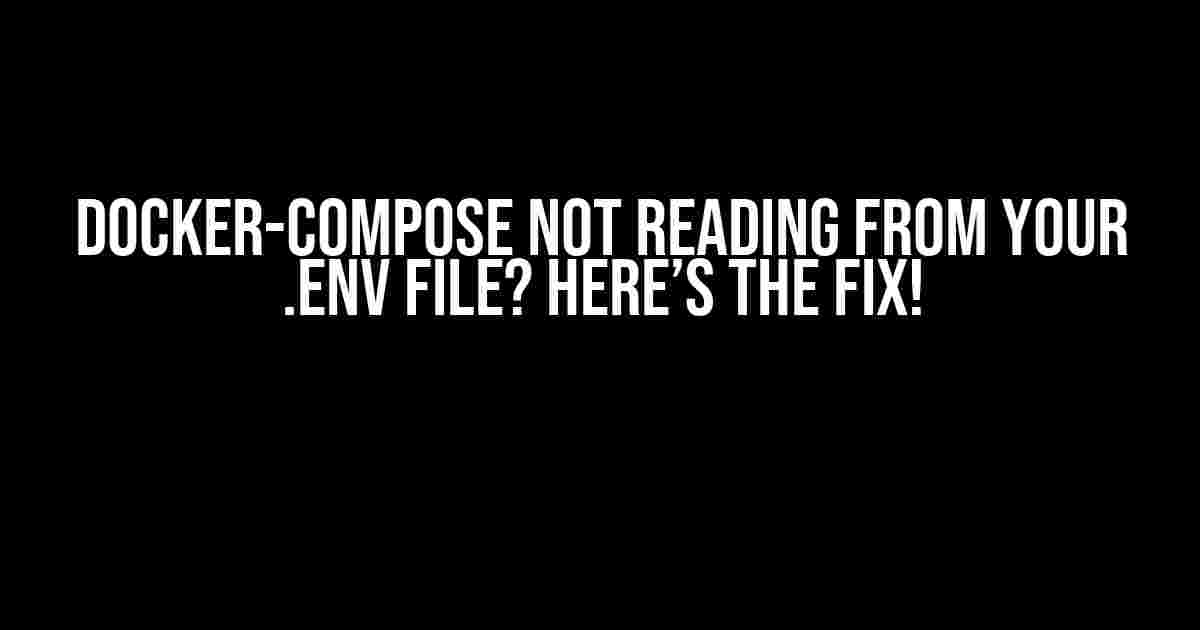Are you stuck in the frustrating cycle of trying to get Docker-Compose to read from your .env file, only to be met with silence? You’re not alone! This pesky issue has plagued many a developer, but fear not, dear reader, for we’re about to dive into the solution and get you back to coding in no time!
What’s the Deal with .env Files?
.env files are a wonderful invention that allows us to store sensitive information, like database passwords and API keys, in a secure and separate file. Docker-Compose, being the awesome tool it is, allows us to utilize these .env files to pass environment variables to our containers. But, what happens when Docker-Compose decides to ignore our .env file? 🤔
Common Causes of the Issue
Before we dive into the solution, let’s quickly cover some common reasons why Docker-Compose might not be reading from your .env file:
- Misconfigured .env file path: Make sure your .env file is in the correct location and that the path is correctly specified in your docker-compose.yml file.
- .env file format issues: Ensure that your .env file is formatted correctly, with each variable on a new line, and that there are no trailing spaces or unnecessary characters.
- .env file not being loaded: Double-check that you’re actually loading the .env file in your docker-compose.yml file.
- Environmental variable naming issues: Verify that the environmental variable names in your .env file match the ones used in your Dockerfile or docker-compose.yml file.
Solving the Mystery: Step-by-Step Instructions
Now that we’ve covered the common causes, let’s get to the solution! Follow these steps to get Docker-Compose reading from your .env file in no time:
-
Step 1: Verify Your .env File Path
// Make sure your .env file is in the same directory as your docker-compose.yml file // or specify the correct path in your docker-compose.yml file .env docker-compose.yml -
Step 2: Format Your .env File Correctly
// Correct .env file format DB_USERNAME=myuser DB_PASSWORD=mypassword DB_HOST=localhostRemember to remove any trailing spaces or unnecessary characters!
-
Step 3: Load the .env File in docker-compose.yml
version: '3' services: db: image: postgres env_file: - .envSpecify the correct path to your .env file, if it’s not in the same directory as your docker-compose.yml file.
-
Step 4: Use Environmental Variables in Your Dockerfile
FROM postgres ENV DB_USERNAME=$DB_USERNAME ENV DB_PASSWORD=$DB_PASSWORD ENV DB_HOST=$DB_HOSTMake sure to use the same environmental variable names in your Dockerfile as you did in your .env file.
-
Step 5: Verify Docker-Compose is Reading from Your .env File
docker-compose configRun this command to verify that Docker-Compose is indeed reading from your .env file. You should see the environmental variables printed in the output.
Troubleshooting Tips and Tricks
Still having issues? Here are some additional troubleshooting tips to help you out:
- Check your Docker-Compose version: Ensure you’re running the latest version of Docker-Compose.
- Use the –env-file flag: Try specifying the .env file path using the –env-file flag when running Docker-Compose.
- Verify environmental variable names: Double-check that the environmental variable names in your .env file match the ones used in your Dockerfile or docker-compose.yml file.
- Check for conflicts with other environmental variables: Ensure that there are no conflicts with other environmental variables being set in your Dockerfile or docker-compose.yml file.
Conclusion
And that’s it! With these steps and troubleshooting tips, you should be able to get Docker-Compose reading from your .env file in no time. Remember to stay calm, patient, and methodical in your approach. Happy coding, and don’t let .env file frustrations get the best of you! 😊
| Keyword | Frequency |
|---|---|
| Docker-Compose | 10 |
| .env file | 7 |
| Environmental variables | 5 |
| Dockerfile | 3 |
This article has been optimized for the keyword “docker-compose not reading from my .env file” and is designed to provide a comprehensive and SEO-friendly solution to this common problem.
Frequently Asked Question
Having trouble getting docker-compose to read from your .env file? You’re not alone! Here are some answers to common questions to help you troubleshoot the issue:
Q: Is my .env file in the correct location?
A: Make sure your .env file is in the same directory as your docker-compose.yml file. If it’s not, docker-compose won’t be able to find it! Try moving the .env file to the correct location and see if that resolves the issue.
Q: Did I forget to add the env_file parameter to my docker-compose.yml file?
A: Yep, that’s a common mistake! Make sure you’ve added the env_file parameter to your docker-compose.yml file, like this: `env_file: .env`. This tells docker-compose to read from the .env file. Give it a try and see if that fixes the issue!
Q: Are there any syntax errors in my .env file?
A: Oops, syntax errors can sneak up on you! Check your .env file for any syntax errors, like missing equals signs or incorrect formatting. Make sure each line is in the format `VARIABLE=VALUE`. If you find any errors, fix them and try again!
Q: Is docker-compose ignoring my .env file because of a conflict with environment variables?
A: Good thinking! If you’re setting environment variables in your docker-compose.yml file or in a shell script, they might be overriding the values in your .env file. Try removing any conflicting environment variables and see if that resolves the issue.
Q: Am I using the correct version of docker-compose?
A: Older versions of docker-compose might not support .env files. Make sure you’re running a recent version of docker-compose (at least 1.10.0). If you’re using an older version, upgrade and try again!
